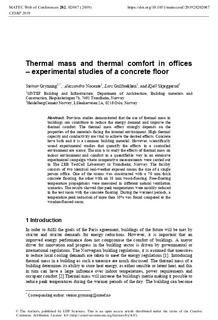| dc.contributor.author | Grynning, Steinar | |
| dc.contributor.author | Nocente, Alessandro | |
| dc.contributor.author | Gullbrekken, Lars | |
| dc.contributor.author | Skjeggerud, Kjell | |
| dc.date.accessioned | 2019-09-16T07:26:51Z | |
| dc.date.available | 2019-09-16T07:26:51Z | |
| dc.date.created | 2019-09-10T10:44:27Z | |
| dc.date.issued | 2019 | |
| dc.identifier.issn | 2261-236X | |
| dc.identifier.uri | http://hdl.handle.net/11250/2616880 | |
| dc.description.abstract | Previous studies demonstrated that the use of thermal mass in buildings can contribute to reduce the energy demand and improve the thermal comfort. The thermal mass effect strongly depends on the properties of the materials facing the internal environment. High thermal capacity and conductivity are vital to achieve the desired effects. Concrete have both and it is a common building material. However, scientifically sound experimental studies that quantify the effects in a controlled environment are scarce. The aim is to study the effects of thermal mass on indoor environment and comfort in a quantifiable way in an extensive experimental campaign where comparative measurements were carried out in The ZEB TestCell Laboratory in Trondheim, Norway. The facility consists of two identical real-weather exposed rooms the size of a single person office. One of the rooms was constructed with a 70 mm thick concrete flooring, the other with an 18 mm wood-flooring. Free-floating temperature propagations were measured in different natural ventilation scenarios. The results showed that peak temperatures were notably reduced in the test room with the concrete flooring. During the warmest periods, a temperature peak reduction of more than 10% was found compared to the wooden-floored room. | nb_NO |
| dc.language.iso | eng | nb_NO |
| dc.publisher | EDP Sciences | nb_NO |
| dc.relation.ispartofseries | CESBP 2019 | |
| dc.rights | CC BY 4.0 | * |
| dc.rights.uri | http://creativecommons.org/licenses/by-nc-nd/4.0/deed.no | * |
| dc.title | Thermal mass and thermal comfort in offices – experimental studies of a concrete floor | nb_NO |
| dc.type | Conference object | nb_NO |
| dc.type | Journal article | nb_NO |
| dc.type | Peer reviewed | nb_NO |
| dc.description.version | publishedVersion | nb_NO |
| dc.rights.holder | © 2019 The authors | nb_NO |
| dc.subject.nsi | VDP::Teknologi: 500 | nb_NO |
| dc.source.journal | MATEC Web of Conferences | nb_NO |
| dc.source.issue | 282 | nb_NO |
| dc.identifier.doi | 10.1051/matecconf/201928202087 | |
| dc.identifier.cristin | 1723152 | |
| cristin.unitcode | 7401,30,40,0 | |
| cristin.unitname | Arkitektur, byggematerialer og konstruksjoner | |
| cristin.ispublished | true | |
| cristin.fulltext | original | |
| cristin.qualitycode | 1 | |

